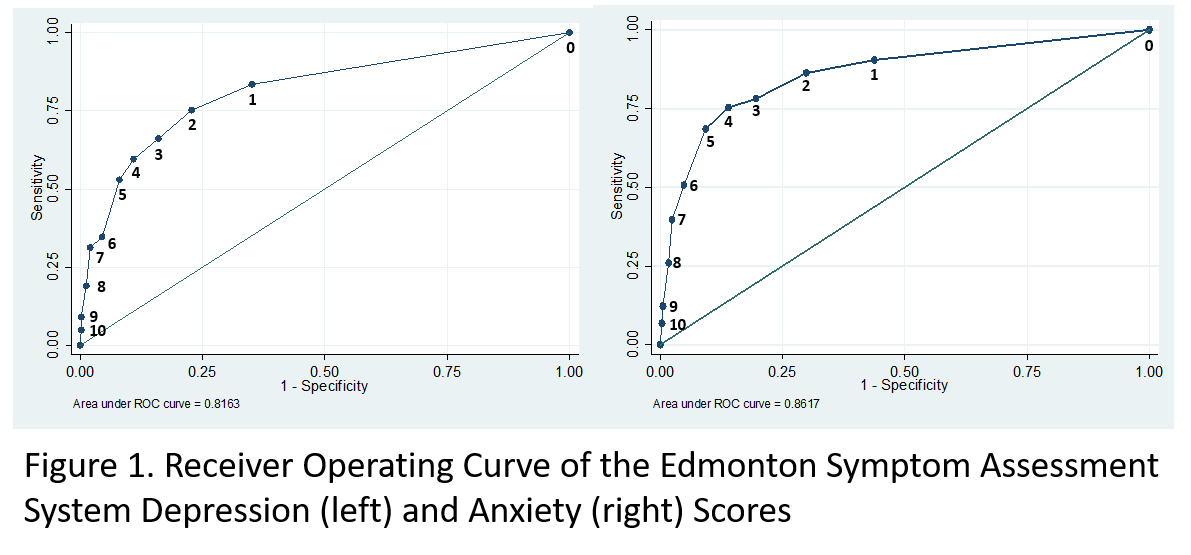Clinical Utility of the Edmonton Symptom Assessment System to Screen for Depression and Anxiety in Kidney Transplant Recipients
E. Tang, S. Dano, A. Ayub, V. Li, I. Escudero, N. Ullah, N. Edwards, M. Novak, I. Mucsi
University Health Network, Toronto, ON, Canada
Meeting: 2019 American Transplant Congress
Abstract number: C111
Keywords: Quality of life
Session Information
Session Name: Poster Session C: Kidney Psychosocial
Session Type: Poster Session
Date: Monday, June 3, 2019
Session Time: 6:00pm-7:00pm
 Presentation Time: 6:00pm-7:00pm
Presentation Time: 6:00pm-7:00pm
Location: Hall C & D
*Purpose: Anxiety and depression are frequent concerns in kidney transplant recipients and are associated with non-adherence and worse clinical outcomes. However, they are often underrecognized due to lack of inquiry. We have recently validated the Edmonton Symptom Assessment System-revised (ESASr) in kidney transplant recipients for symptoms assessment. Here we asses the measurement characteristics of ESASr to screen for anxiety and depression.
*Methods: A cross-sectional sample of stable kidney transplant recipients completed legacy instruments (patient health questionnaire (PHQ-9) and generalized anxiety disorder (GAD-7)) and the ESASr. In this analysis we focused on the ESASr-A (anxiety) and ESASr-D (depression) items. The correlation between the legacy and ESASr scores was compared using spearman’s rho. Discrimination was assessed using receiver operating characteristic (ROC) analysis. We determined the cut-off to identify potential “cases” that require further assessment using Youden’s J. We also constructed a Bayesian conditional probability plot integrating pre-test probability and likelihood ratios.
*Results: Mean(±SD) age of the 270 participants was 51 (±16), 61% were male and 55% Caucasian. Spearman’s correlation between ESASr and the legacy questionnaires was moderately strong (ESASr-A/GAD-7: 0.64; ESASr-D/PHQ-9: 0.61). Good discrimination was found on ROC analysis (area under the curve ESASr-A 0.86; ESASr-D 0.82) (Figure 1.). From the ROC, the optimal cut off was ≥4 for ESASr-A (Sensitivity = 0.75; Specificity = 0.86) and ≥2 for ESASr-D (Sensitivity = 0.75; Specificity = 0.77).
*Conclusions: ESAS-A and ESAS-D show good correlation with the respective legacy questionnaires. The identified cut-offs show good discrimination for moderate anxiety/depression (NPV and sensitivity). The findings may support the potential for ESASr use as an initial screening tool, with the ability to identify cases with only a few false negatives. Positive results can be paired with a second screening tool to identify true cases.
To cite this abstract in AMA style:
Tang E, Dano S, Ayub A, Li V, Escudero I, Ullah N, Edwards N, Novak M, Mucsi I. Clinical Utility of the Edmonton Symptom Assessment System to Screen for Depression and Anxiety in Kidney Transplant Recipients [abstract]. Am J Transplant. 2019; 19 (suppl 3). https://atcmeetingabstracts.com/abstract/clinical-utility-of-the-edmonton-symptom-assessment-system-to-screen-for-depression-and-anxiety-in-kidney-transplant-recipients/. Accessed December 25, 2025.« Back to 2019 American Transplant Congress

